Ankylosing Spondylitis and Eyes: Understanding the Connection and Treatment Options
How does ankylosing spondylitis affect your eyes. What are the symptoms of uveitis in AS patients. How is uveitis related to ankylosing spondylitis diagnosed and treated. What are the long-term effects of untreated uveitis in AS.
The Link Between Ankylosing Spondylitis and Eye Problems
Ankylosing spondylitis (AS) is a chronic inflammatory condition primarily affecting the spine. However, its impact extends beyond joint pain and stiffness, often manifesting in unexpected ways – including eye problems. One of the most common ocular complications associated with AS is uveitis, a form of eye inflammation that can have serious consequences if left untreated.
Uveitis occurs in approximately 25-35% of individuals with ankylosing spondylitis, making it a significant concern for AS patients. This eye condition can develop at any stage of AS, sometimes even before the classic spinal symptoms appear. Understanding the connection between AS and eye health is crucial for early detection and proper management of ocular complications.

What is Uveitis and How Does It Relate to Ankylosing Spondylitis?
Uveitis refers to inflammation of the uvea, the middle layer of the eye that includes the iris, ciliary body, and choroid. In the context of ankylosing spondylitis, uveitis most commonly affects the anterior (front) part of the eye, a condition known as anterior uveitis or iritis.
The exact mechanism linking AS and uveitis is not fully understood, but researchers believe it involves a combination of genetic predisposition and immune system dysfunction. Many AS patients carry the HLA-B27 gene, which is also associated with an increased risk of developing uveitis.
Types of Uveitis in Ankylosing Spondylitis
- Anterior uveitis: Inflammation of the iris and ciliary body
- Intermediate uveitis: Inflammation of the vitreous
- Posterior uveitis: Inflammation of the choroid and retina
- Panuveitis: Inflammation affecting all parts of the uvea
While anterior uveitis is the most common form in AS patients, other types can occur as well. Each type presents unique challenges and requires specific treatment approaches.

Recognizing the Symptoms of Uveitis in Ankylosing Spondylitis Patients
Early detection of uveitis is crucial for preventing vision loss and other complications. AS patients should be vigilant about potential eye symptoms and seek prompt medical attention if they experience any of the following:
- Eye redness or bloodshot appearance
- Eye pain or discomfort
- Blurred or cloudy vision
- Increased sensitivity to light (photophobia)
- Floaters or dark spots in the visual field
- Decreased vision
These symptoms can develop rapidly, often affecting one eye at a time. In some cases, uveitis may alternate between eyes or affect both simultaneously. The intensity and duration of symptoms can vary, ranging from acute episodes lasting a few weeks to chronic cases persisting for months or years.
Diagnosing Uveitis in Ankylosing Spondylitis: The Importance of Regular Eye Exams
Diagnosing uveitis in AS patients requires a comprehensive eye examination by an ophthalmologist or optometrist. Regular eye check-ups are essential for individuals with ankylosing spondylitis, even in the absence of noticeable symptoms.
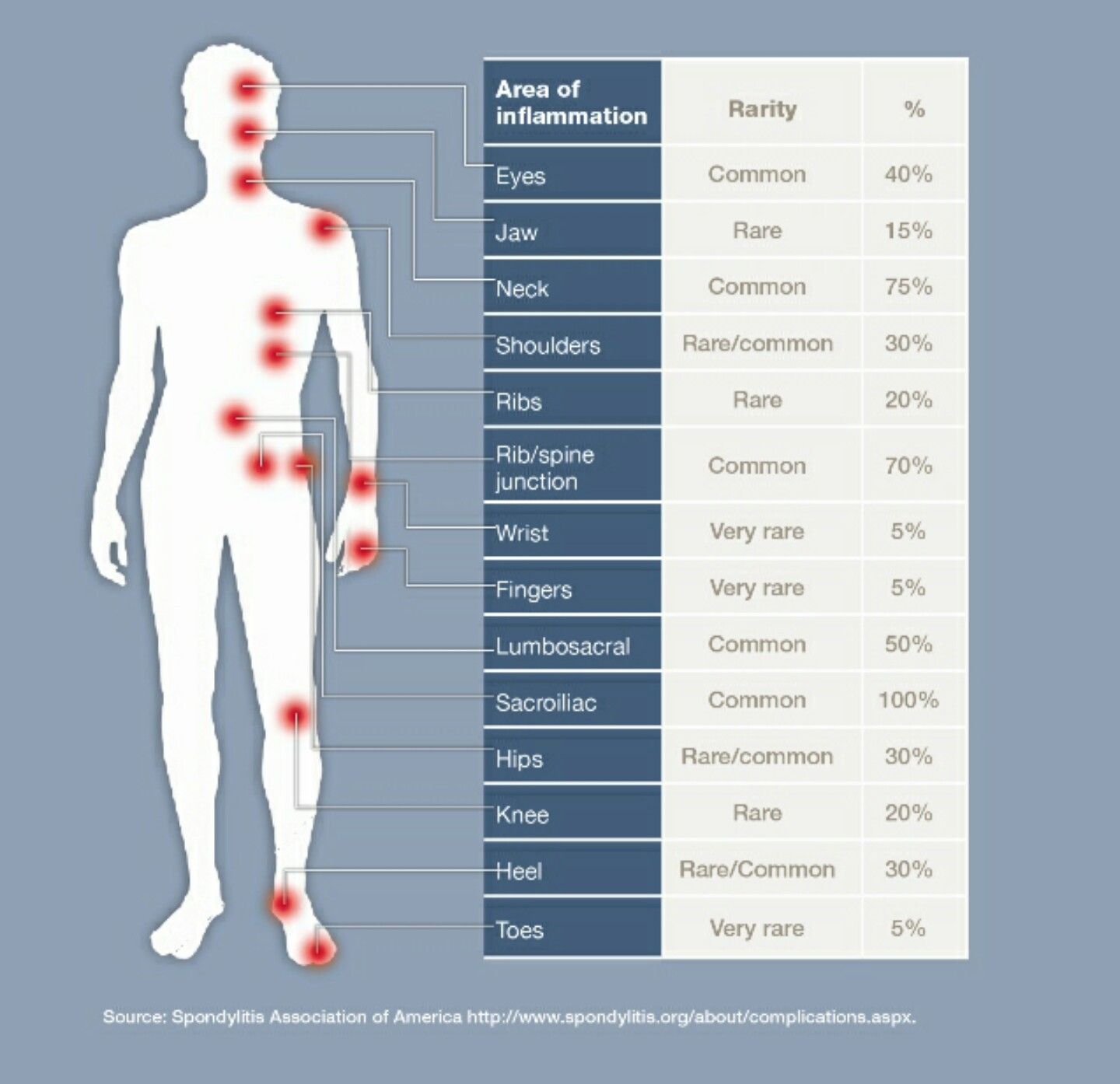
During an eye exam, the healthcare provider may perform several tests to assess eye health and detect signs of inflammation:
- Visual acuity test
- Slit-lamp examination
- Dilated fundus examination
- Tonometry (to measure intraocular pressure)
- Optical coherence tomography (OCT)
In some cases, additional tests such as fluorescein angiography or ultrasound may be necessary to evaluate the extent of inflammation and rule out other eye conditions.
Treatment Options for Uveitis in Ankylosing Spondylitis Patients
The primary goal of uveitis treatment is to reduce inflammation, alleviate symptoms, and prevent complications. The choice of treatment depends on the severity and location of inflammation, as well as the patient’s overall health and AS management plan.
Topical Treatments
For mild to moderate cases of anterior uveitis, topical medications are often the first line of treatment:
- Corticosteroid eye drops: To reduce inflammation
- Cycloplegic eye drops: To relieve pain and prevent complications
- Non-steroidal anti-inflammatory drops: To manage pain and inflammation
Systemic Treatments
In more severe cases or when topical treatments are insufficient, systemic medications may be necessary:
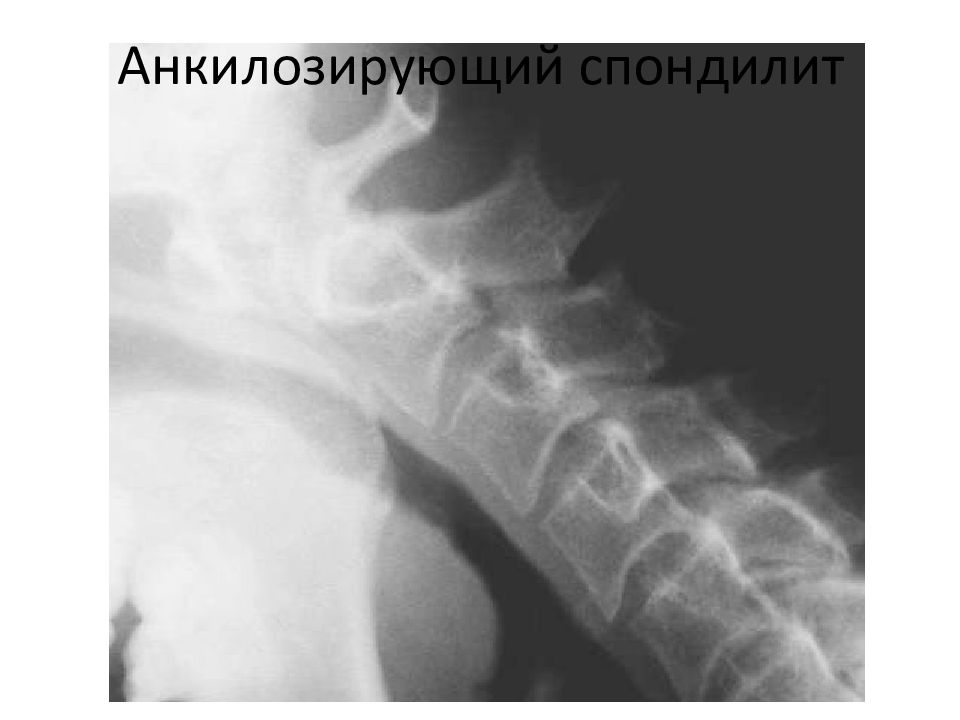
- Oral corticosteroids
- Immunosuppressants (e.g., methotrexate, mycophenolate)
- Biologic agents (e.g., TNF inhibitors, IL-17 inhibitors)
These systemic treatments often have the added benefit of addressing both the ocular inflammation and the underlying ankylosing spondylitis symptoms.
Advanced Treatments
For refractory cases or those at high risk of vision loss, more aggressive treatments may be considered:
- Intraocular steroid injections
- Steroid implants
- Surgical interventions (in rare cases)
Preventing Uveitis Flares in Ankylosing Spondylitis
While it may not be possible to completely prevent uveitis in AS patients, several strategies can help reduce the frequency and severity of flares:
- Adhering to prescribed AS treatments to control overall inflammation
- Maintaining regular eye check-ups, even when asymptomatic
- Promptly reporting any eye symptoms to a healthcare provider
- Managing stress through relaxation techniques and lifestyle modifications
- Avoiding smoking and limiting alcohol consumption
- Protecting eyes from UV radiation with sunglasses
- Maintaining a healthy diet rich in anti-inflammatory foods
Some research suggests that probiotics and prebiotics may help support gut health and potentially reduce inflammation throughout the body, including the eyes. However, more studies are needed to confirm their efficacy in preventing uveitis specifically.
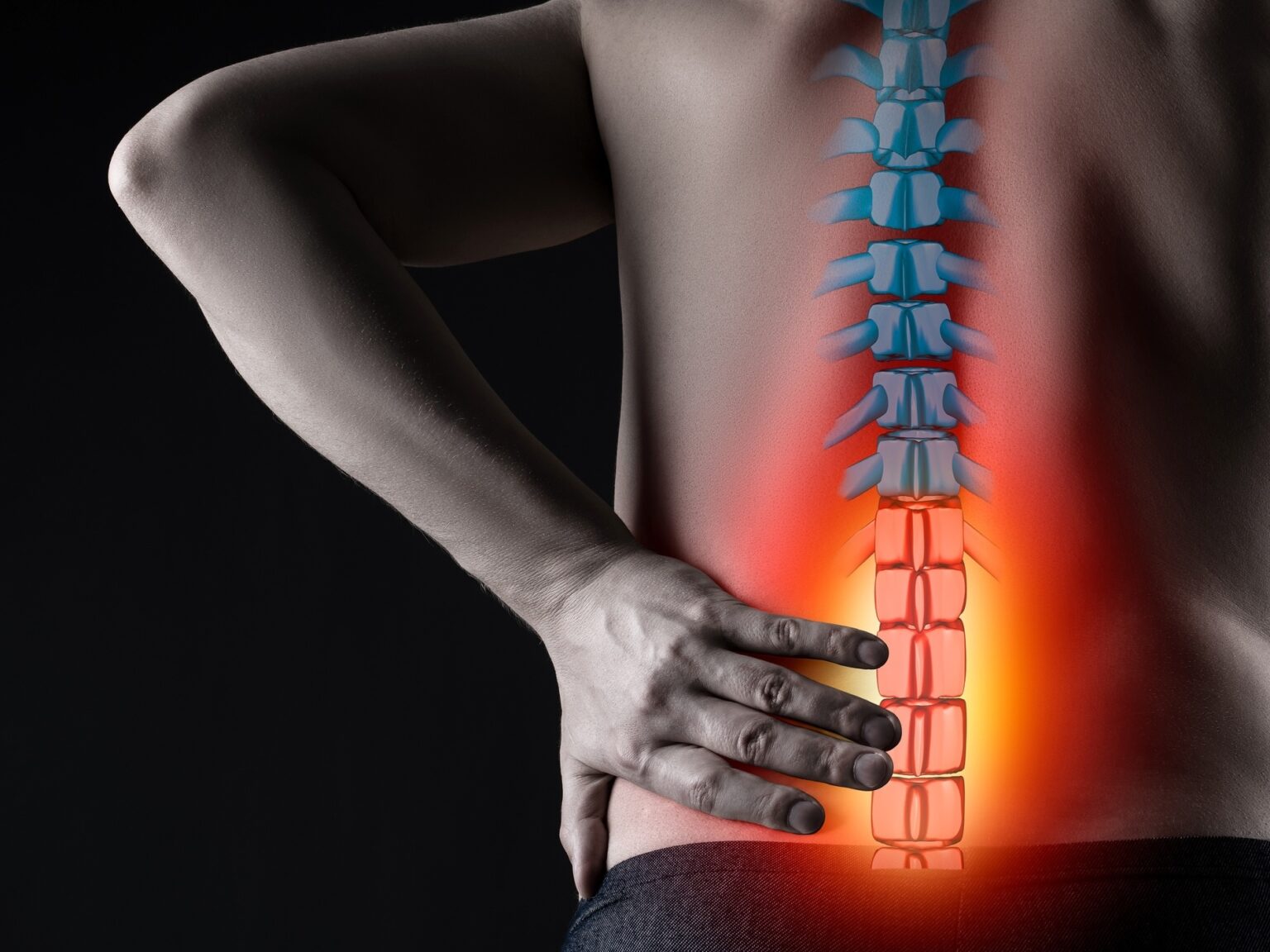
Long-term Outlook and Potential Complications of Untreated Uveitis in AS
When left untreated, uveitis can lead to serious complications that may permanently affect vision. AS patients with recurring or chronic uveitis are at increased risk for:
- Cataracts: Clouding of the eye’s natural lens
- Glaucoma: Increased pressure within the eye
- Macular edema: Swelling in the central part of the retina
- Retinal detachment: Separation of the retina from the back of the eye
- Band keratopathy: Calcium deposits on the cornea
- Synechiae: Adhesions between the iris and lens or cornea
These complications underscore the importance of early detection and proper management of uveitis in ankylosing spondylitis patients. With appropriate treatment and regular monitoring, many individuals with AS-related uveitis can maintain good eye health and preserve their vision.
The Role of Multidisciplinary Care in Managing AS-Related Eye Problems
Effective management of ankylosing spondylitis and its ocular complications often requires a collaborative approach involving multiple healthcare specialists. This multidisciplinary team may include:
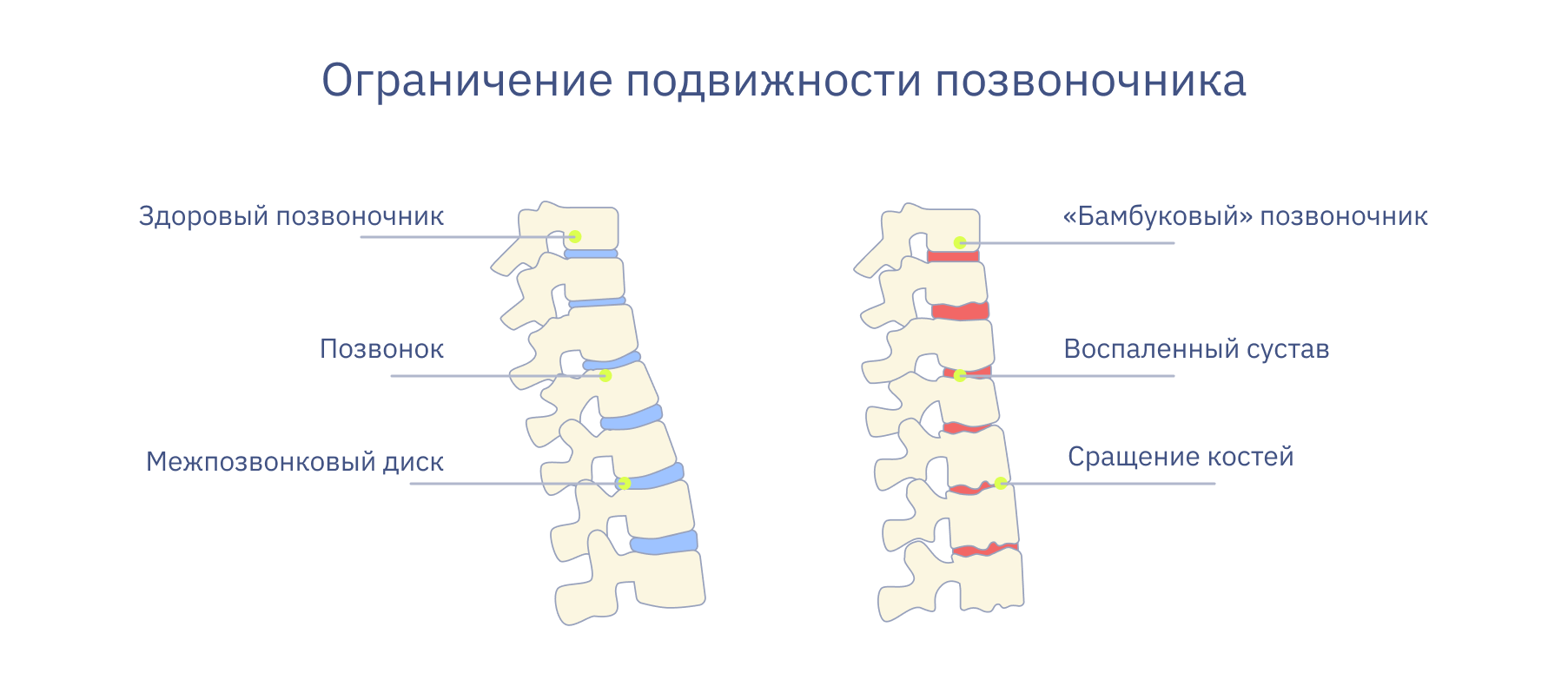
- Rheumatologists: To manage the underlying AS
- Ophthalmologists: To diagnose and treat uveitis
- Optometrists: For regular eye exams and vision care
- Primary care physicians: To coordinate overall health management
- Physical therapists: To address AS-related mobility issues
- Nutritionists: To provide dietary guidance for inflammation management
Coordinated care ensures that both the systemic and ocular aspects of ankylosing spondylitis are addressed comprehensively, leading to better outcomes for patients.
Emerging Research and Future Directions in AS-Related Eye Care
The field of AS-related eye care is continuously evolving, with ongoing research aimed at improving diagnosis, treatment, and prevention of uveitis and other ocular complications. Some promising areas of investigation include:
- Genetic markers for predicting uveitis risk in AS patients
- Novel biologic therapies targeting specific inflammatory pathways
- Advanced imaging techniques for earlier detection of eye inflammation
- Personalized treatment approaches based on genetic and biomarker profiles
- Potential role of gut microbiome modulation in managing AS and uveitis
As research progresses, AS patients can expect more targeted and effective strategies for managing eye health and preserving vision in the context of their condition.

Living with Ankylosing Spondylitis and Uveitis: Patient Perspectives and Coping Strategies
Coping with both ankylosing spondylitis and recurrent uveitis can be challenging for many patients. However, numerous strategies can help individuals manage their condition and maintain a good quality of life:
- Education: Learning about AS and uveitis empowers patients to take an active role in their care
- Support groups: Connecting with others who share similar experiences can provide emotional support and practical advice
- Stress management: Techniques such as meditation, yoga, or counseling can help reduce stress-related flares
- Adaptive technologies: Using assistive devices during periods of vision impairment can help maintain independence
- Workplace accommodations: Discussing potential adjustments with employers to accommodate vision changes or treatment needs
- Healthy lifestyle choices: Maintaining a balanced diet, regular exercise, and adequate sleep to support overall health
By adopting these strategies and working closely with their healthcare team, many AS patients with uveitis can effectively manage their condition and lead fulfilling lives.
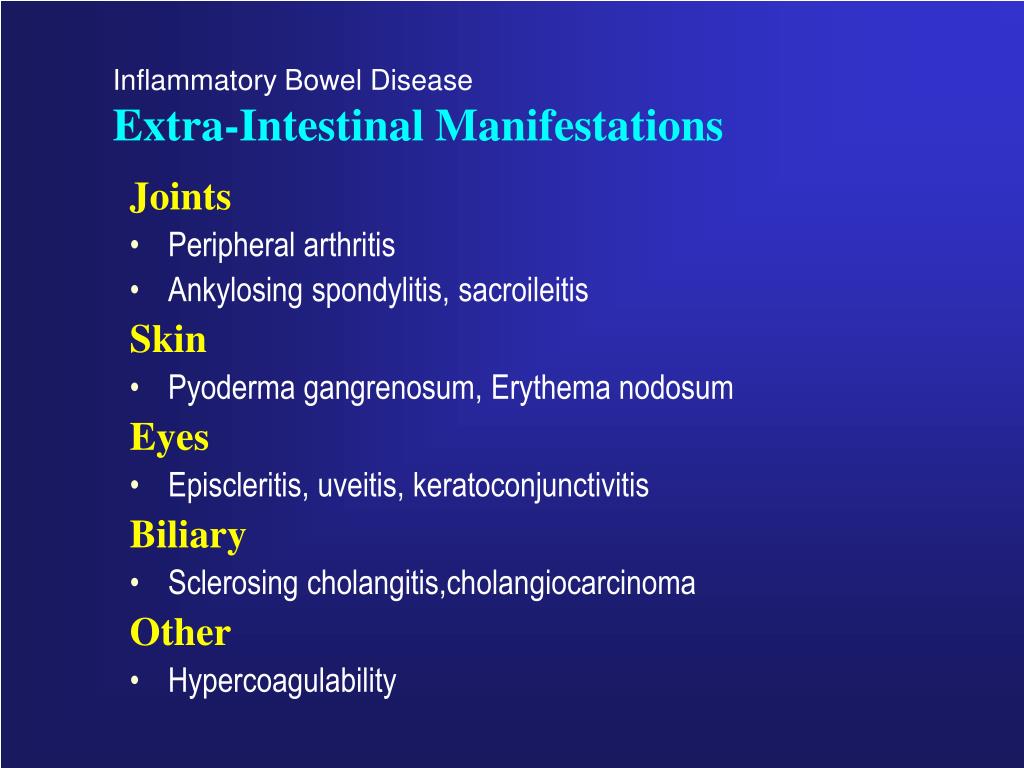
Understanding the connection between ankylosing spondylitis and eye health is crucial for comprehensive patient care. By recognizing the signs of uveitis, seeking prompt treatment, and adopting preventive measures, individuals with AS can protect their vision and maintain overall well-being. As research continues to advance, the outlook for managing AS-related eye complications continues to improve, offering hope for better outcomes and quality of life for those affected by this challenging condition.
How It Can Affect Your Eyes
Written by Linda Rath
- What Is Uveitis?
- Why People With AS Get It
- Symptoms
- Treatments
Ankylosing spondylitis (AS) is a type of arthritis. It causes pain and stiffness, mainly in your spine. But it can also cause eye inflammation called uveitis. Left untreated, uveitis can harm your vision and, in some cases, lead to blindness.
Uveitis is a large group of inflammatory eye diseases. It gets its name from the fact that these diseases mostly strike the uvea, the middle part of your eye. But uveitis can show up almost anywhere inside the eye.
Doctors usually describe uveitis based on where you have it:
Anterior uveitis (also called iritis) happens in the front part of your eye. That includes the iris, the colored part. It’s the most common type of uveitis for people with AS. If it’s not treated, anterior uveitis can lead to cataracts, glaucoma, or a buildup of fluid called retinal edema.
Intermediate uveitis is in the vitreous. That’s the big, fluid-filled space in your eye attached to your retina, a layer of cells that sense light and send signals to your brain.
Posterior uveitis (also called choroiditis) attacks the back of your eye. It may affect your retina and your optic nerve, which connects your eye to your brain.
Panuveitis affects all parts of your eye. It’s the most severe type. It can cause blindness if it’s not treated.
About half of people with ankylosing spondylitis have uveitis at least once. It’s one of the most common complications of that form of arthritis.
Your eye doctor could actually be the first to figure out you have AS. That’s because the same inflammation that makes your back hurt can also cause inflammation in your eyes and other parts of your body.
Some experts think the inflammation starts in a place you might not think of: your gut.
It’s home to trillions of tiny organisms called microbes.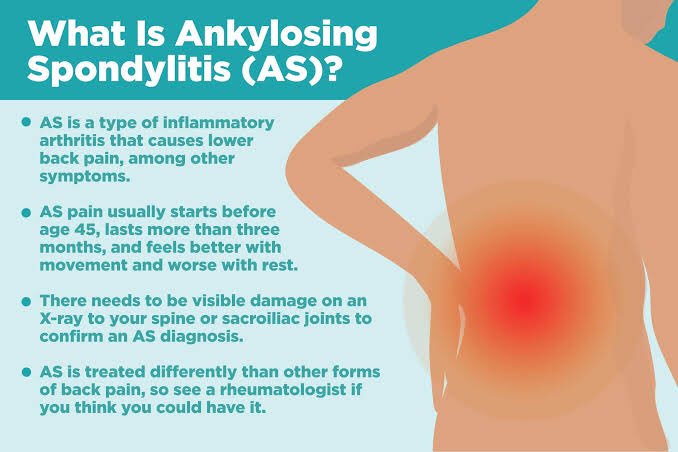 They perform so many vital functions that you can’t live without them. One of their main jobs is to control your immune system. When the microbes get out of whack, your immune system does, too.
They perform so many vital functions that you can’t live without them. One of their main jobs is to control your immune system. When the microbes get out of whack, your immune system does, too.
Uveitis may start when gut bacteria tell immune cells called T cells to attack your eyes. But that’s probably not the whole story. Many people with AS and anterior uveitis have a gene called HLA-B27. This gene makes eye inflammation much more likely.
Keep an eye out for:
- Redness
- Pain
- Blurred vision
- Sensitivity to bright light
These symptoms can come on quickly in one or both eyes. Sometimes uveitis is a one-time thing. In other cases, you may go years between flares. In still others, it can also be long-lasting and need ongoing treatment.
The goal of uveitis treatment is to ease inflammation fast. For anterior uveitis, doctors usually prescribe two types of eye drops:
- Steroid drops to lower inflammation
- Drops that widen your pupil to ease pain
For other types of uveitis, you may need steroid pills or shots around your eyes. Sometimes doctors implant a steroid capsule inside your eye.
Sometimes doctors implant a steroid capsule inside your eye.
Steroids can cause serious side effects, including eye diseases like glaucoma and cataracts. Usually, you won’t use steroids for more than 3 months. As you taper off them, your doctor may start you on another medicine.
Some experts think a change in gut bacteria can ease uveitis. You might try:
Probiotics. These are live, friendly bacteria. You find them in yogurt and other fermented foods. They’re in supplements, too.
Prebiotics. These plant fibers feed healthy bacteria in your gut and make them stronger. You can find them in foods like bananas and onions.
Supplements for gut health like butyrate are another option. A diet that’s mostly plant-based could also help.
Talk with your doctor to find out which treatment might work best for you.
Top Picks
Why Ankylosing Spondylitis Causes Eye Pain – Cleveland Clinic
Ankylosing spondylitis (AS) is a type of inflammatory arthritis that typically affects your lower back.
While those who have AS may experience stiffness, fatigue and pain, the autoimmune condition can also cause eye inflammation known as uveitis.
Rheumatologist Ahmed Elghawy, DO, explains why you may experience eye problems and what treatments are available.
Why does AS cause eye pain?
The short answer is: Doctors aren’t entirely sure.
“With autoimmune conditions like ankylosing spondylitis, your body is acting inappropriately against its own tissue,” explains Dr. Elghawy. “We think this is also the case when it comes to uveitis. There may have been some sort of pathogen that could have led to the body recognizing a self-antigen instead of the pathogen. The body makes the mistake of attacking itself.”
There may also be a link between a certain gene known as HLA-B27 that’s common in both ankylosing spondylitis and uveitis.
Between 25% to 35% of individuals with ankylosing spondylitis will go on to develop some sort of uveitis.
There are different types of uveitis:
Advertising Policy
- Anterior uveitis.
 This affects the front part of your eye, including your iris. About 90% of people with AS will develop this type.
This affects the front part of your eye, including your iris. About 90% of people with AS will develop this type. - Posterior uveitis. The back part of your eye is affected, including your retina and optic nerve.
- Intermediate uveitis. This type attacks your vitreous, the clear fluid between your lens and retina.
- Panuveitis. This type affects every part of your eye. It’s the most severe type.
“The longer the patient has ankylosing spondylitis, the more likely they are to develop uveitis,” says Dr. Elghawy.
Uveitis symptoms
Uveitis typically only affects one eye at a time; though, it’s possible to have symptoms in both eyes at once.
If you have uveitis, you may experience the following symptoms:
- Redness.
- Swelling.
- Inflammation.
- Pain.
- Blurred vision.
- Sensitivity to light.
- Increased floaters or spots in your vision.
- Decreased vision.

“In people who are older, uveitis increases the risk of developing cataracts or glaucoma or making those conditions worse,” says Dr. Elghawy.
Treating eye pain and AS
If not treated, uveitis can harm your vision and could potentially lead to blindness.
“We recommend that those who have eye issues at all, especially who already carry a diagnosis of ankylosing spondylitis, that they let their doctor know immediately because it needs to be it needs to be addressed quickly,” emphasizes Dr. Elghawy.
Your doctor will not only treat uveitis, but will also treat your ankylosing spondylitis. In many cases, your rheumatologist may suggest you see an ophthalmologist, too.
Advertising Policy
Treatment options for uveitis may include anti-inflammatory eye drops or eye drops with corticosteroids.
Treatments options for AS can include:
- Nonsteroidal anti-inflammatory drugs (NSAIDs). Either an over-the-counter or prescription NSAID can work as an anti-inflammatory and help with other symptoms as well.

- Disease-modifying anti-rheumatic drugs (DMARDs). This type of drug can also help control your overactive immune system and help with symptoms.
- Corticosteroids. To help temporarily ease joint pain and inflammation, your doctor may recommend an injection of corticosteroids.
Often, the biologic therapies used for ankylosing spondylitis also address uveitis.
“A common scenario would be a person who has low back pain and was treated with prescription or over-the-counter NSAIDs. They’re doing well, but later they develop eye issues, and then, that’s what kind of prompts us to start the biologic therapy,” explains Dr. Elghawy. “There are other individuals who are on biologic therapy who never go on to develop uveitis and that’s probably because they’re already being treated with the biologic therapy.”
And don’t overlook the importance of regular eye exams, says Dr. Elghawy.
“Sometimes, you may find evidence of uveitis during a typical eye exam, even before you have symptoms,” he adds.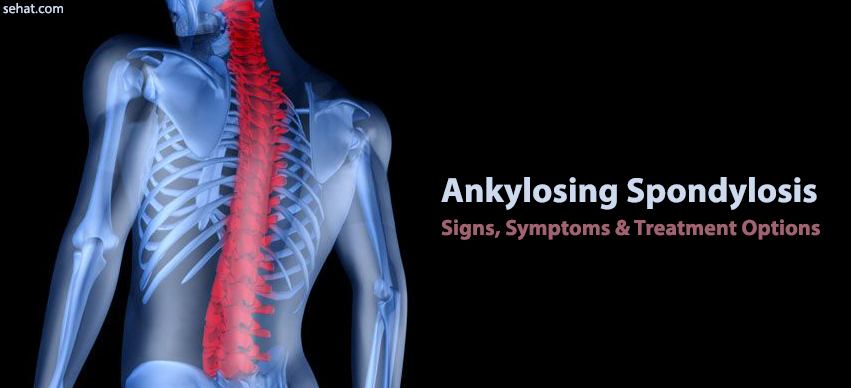 “So, it’s important if you do have evidence of uveitis, it’s treated properly to prevent the long-term consequences.”
“So, it’s important if you do have evidence of uveitis, it’s treated properly to prevent the long-term consequences.”
Bechterew’s disease: possible complications | Clinical Diagnostic Center
“Bekhterev’s disease”: possible complications / Interview with Anna Okhotnikova, 24-hour hospital rheumatologist of the 24-hour hospital “KDC” spine and sacroiliac joints , which can occur simultaneously with damage to peripheral joints, entheses and internal organs. Anna Okhotnikova, a rheumatologist at the CDC round-the-clock hospital, talks about the symptoms of the disease and its various consequences for the body:
Clinical manifestations of spondyloarthritis are varied, they appear gradually, sometimes imperceptibly for the patient, long spontaneous remissions are often observed at the onset of the disease. Ankylosing spondylitis most often begins with inflammatory back pain (in 75-85% of cases) and peripheral arthritis (in 15-25% of cases)
The onset of ankylosing spondylitis is characterized by the following symptoms:
Deep-seated pain in the spine associated with restriction of movement in the lumbar
Morning stiffness of the spine that disappears during the day.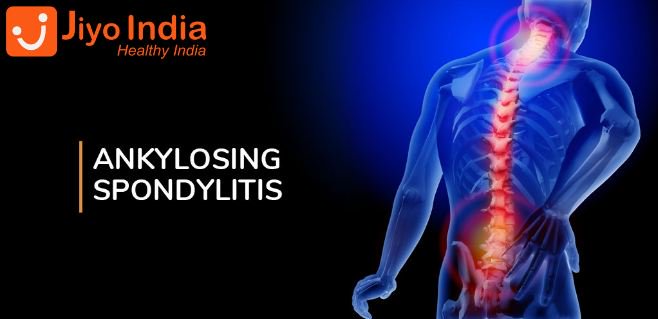
The central place in the clinical picture is occupied by the lesion of the axial skeleton (spine, pelvis, hip, shoulder and mandibular joints).
Criteria for inflammatory back pain are:
slow (creeping) onset extending over weeks
nocturnal pain better on waking
better with exercise
worse during sleep and at rest .
Inflammatory pain reflexively causes muscle spasm, which contributes to the development of stiffness of the spine. In the early stages of the disease, the restriction of movements in the spine is due to inflammation and painful spasm of the muscles of the back, in the later stages – mainly ossification of the spine.
If the thoracic spine, costovertebral joints are affected, there is pain in the chest, sometimes encircling, aggravated by coughing, deep breathing, turning the torso. As a result of damage to the costovertebral joints, the respiratory excursion of the chest decreases, while the respiratory function is compensated by the diaphragm.
Damage to the joints of the anterior chest wall (sternoclavicular, sternocostal, manubrium and body of the sternum) can be observed at any stage of the disease. Arthritis of the joints of the anterior chest wall occurs in ankylosing spondylitis in 17% of cases. Symptoms can range from mild soreness to severe, firm swelling.
Involvement of the cervical spine occurs at a later stage of the disease. Initially, pain appears, the range of motion of the neck gradually decreases: rotation and inclinations are limited. In some cases, complete ankylosis of the cervical spine occurs with absolute immobility of the head and neck. Spondylitis of the cervical spine may result in dyscirculatory encephalopathy, accompanied by dizziness, nausea, and headache.
Peripheral joint involvement can occur at any stage of the disease and is sometimes one of the first symptoms. In more than 50% of patients, peripheral joints are involved in the process, including the hip and shoulder joints. Peripheral arthritis can be either a temporary manifestation of the disease and pass without a trace, or a frequently recurring manifestation leading to a permanent dysfunction of the joint. Large and medium joints of the lower extremities (hip, knee, ankle) are predominantly involved, arthritis of individual joints of the toes is possible, temporomandibular joints may be affected.
Peripheral arthritis can be either a temporary manifestation of the disease and pass without a trace, or a frequently recurring manifestation leading to a permanent dysfunction of the joint. Large and medium joints of the lower extremities (hip, knee, ankle) are predominantly involved, arthritis of individual joints of the toes is possible, temporomandibular joints may be affected.
A special variant of arthritis in this disease is damage to the hip joint (coxitis). It develops in about 1/3 of patients with ankylosing spondylitis; in adults, coxitis develops in the first 10 years of the disease. It is manifested by pain in the inguinal region, which can radiate along the anterior and lateral surface of the thigh, to the buttocks, and the anterior surface of the lower leg. It is possible to identify asymptomatic x-ray changes in the hip joints.
In addition to pain in the joints, there are also pains in the bones. We are talking about inflammation of those places where the tendons are attached to the bones./hyponatremia-overview-4586684_final-fc297d28a05a401c967ff6cc8a64d79d.png) The very first symptoms of Bechterew’s disease are sometimes pains in the heels, which make standing on a hard floor very unpleasant. Inflammation of the attachment of the tendons at the ischium makes sitting on hard chairs unpleasant. Other tendon attachments may also be affected. Inflammation of the tendon attachments is so characteristic of Bechterew’s disease that, together with other characteristic signs, they can even be considered as a diagnostic criterion.
The very first symptoms of Bechterew’s disease are sometimes pains in the heels, which make standing on a hard floor very unpleasant. Inflammation of the attachment of the tendons at the ischium makes sitting on hard chairs unpleasant. Other tendon attachments may also be affected. Inflammation of the tendon attachments is so characteristic of Bechterew’s disease that, together with other characteristic signs, they can even be considered as a diagnostic criterion.
Ankylosing spondylitis is a “systemic disease”. The erroneous functioning of the immune system can also manifest itself in other organs, not only in the spine. General clinical manifestations of the disease:
fever in the evening not higher than 37.5 C, lethargy, weight loss with preserved appetite, fatigue.
EYES. Approximately 40% of patients develop eye inflammation at one or more times in their lives. We are talking about iritis (inflammation of the iris). If, in addition to the iris, the adjacent areas of the eye also become inflamed, the doctor speaks of iridocyclitis or uveitis. The eye hurts (especially with large changes in brightness, at which the pupil should constrict), becomes sensitive to pressure and reddens.
The eye hurts (especially with large changes in brightness, at which the pupil should constrict), becomes sensitive to pressure and reddens.
HEART. Pathology from the side of the heart occurs more often, the longer the disease lasts and the more severe it is. After a 15-year duration of the disease, 3.5%, and after a 30-year duration, 8-10%. Inflammatory changes in the heart caused by Bechterew’s disease develop where the aorta exits the heart. They can lead to heart valve failure (the valve no longer closes properly and blood flows back into the heart with every heartbeat). But inflammation can also block nerve regulation between the atrium and the main chamber and lead to abnormal heart rhythms. To avoid these unpleasant complications, it is important for patients to eliminate or reduce risk factors such as smoking, high blood pressure, being overweight, and lack of exercise.
LIGHT. Lung function is maintained through abdominal breathing, even with complete ossification of the costal joints. But the volume of breathing can be severely limited. In about 15% of patients, this results in upper lung fibrosis (an overgrowth of the connective tissue in the lung), which makes it easier for bacteria and fungi to infect the lungs. The countermeasure against this side effect (along with stopping smoking as a risk factor) is to maintain as much breathing volume as possible, which can be achieved with the help of breathing exercises and physical training.
But the volume of breathing can be severely limited. In about 15% of patients, this results in upper lung fibrosis (an overgrowth of the connective tissue in the lung), which makes it easier for bacteria and fungi to infect the lungs. The countermeasure against this side effect (along with stopping smoking as a risk factor) is to maintain as much breathing volume as possible, which can be achieved with the help of breathing exercises and physical training.
KIDNEYS and LIVER. Due to inflammatory processes in almost all organs, there is a deposition of protein molecules, which is called amyloid. In the late stage, the lack of volume of the kidneys and liver can limit the function of these organs. Then they talk about amyloidosis. It is treated with diet and cortisone-containing drugs. Amyloidosis is a compelling reason to use these drugs despite their side effects.
NERVOUS SYSTEM. Rarely, but still, complications in the nervous system occur in the late stage of ankylosing spondylitis.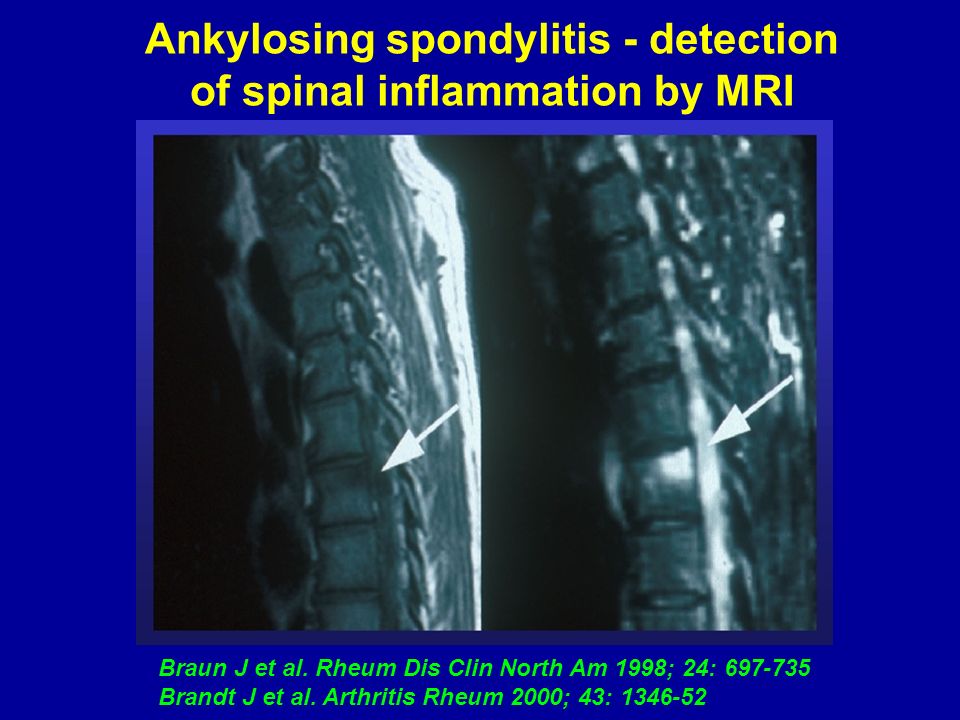 Due to the complete ossification of the edges of the intervertebral discs, myelopathy (disease of the spinal cord) can be caused. A similar picture can be caused by displacements between the first and second cervical vertebrae.
Due to the complete ossification of the edges of the intervertebral discs, myelopathy (disease of the spinal cord) can be caused. A similar picture can be caused by displacements between the first and second cervical vertebrae.
With the patient’s correct and reasonable understanding of his illness, the attention and support of a competent specialist, mutual cooperation, with an optimistic attitude and active participation of the patient in the treatment and rehabilitation process, Bechterew’s disease can be controlled.
Uveitis in autoimmune diseases
Semashko Clinical Hospital
3rd Ophthalmological Department
Ophthalmologist Borodulina M.N.
In modern ophthalmology, uveitis refers to various types of intraocular inflammation – from iritis to chorioretinitis. Generalized inflammation is called panuveitis.
The role of the immune system
The eye is reliably protected by immunity against the occurrence of infectious uveitis, but the components of the immune system themselves can provoke an inflammatory process. Its memory cells remain in the eye long enough to trigger a recurrence of intraocular inflammation the next time it encounters a pathogen.
Its memory cells remain in the eye long enough to trigger a recurrence of intraocular inflammation the next time it encounters a pathogen.
In addition, the immune system is also activated during molecular mimicry – the disguise of some microorganisms as their own cells of the human body. Chlamydia, Klebsiella, Yersinia have this feature. The impact of external factors can also trigger pathological autoimmune reactions that affect organs and systems.
Uveitis in autoimmune diseases
Uveitis often accompanies human autoimmune diseases. Sometimes it is the debut of the disease. But more often it develops after the appearance of systemic symptoms.
Uveitis in autoimmune pathology has its own characteristics:
More often it is an anterior variant, an acute course. An exception would be chronic uveitis in the case of juvenile rheumatoid arthritis in girls. Posterior and generalized variants may occur.
Bilateral lesion is characteristic, in contrast to infectious diseases. The eyes can be affected asymmetrically, with a different time interval.
The eyes can be affected asymmetrically, with a different time interval.
The type of course depends on the underlying pathology. Uveitis can be indolent or continuously relapsing. In Bechterew’s disease, the recurrence rate is very variable.
The combination of uveitis with systemic symptoms – lesions of the skin, musculoskeletal system, lungs – should be alert for a possible autoimmune disease. This should also be considered when uveitis does not respond to standard therapy.
Sarcoidosis
This disease is a systemic granulomatosis predominantly affecting the lungs and, to a lesser extent, the skin. Women of young and middle age are ill more often. The frequency of eye damage can reach 40%.
Uveitis is more often anterior or generalized. Granulomas are found in the retina and choroid. They may also be present in the conjunctiva of the eyelids.
Symptoms of granulomatous uveitis in sarcoidosis:
- “flies” before the eyes;
- decreased visual acuity;
- pain
Examination shows nodules and fatty precipitates in the iris.
Complications of granulomatous uveitis are cataract, glaucoma, hypotension and subatrophy of the eyeball. In posterior uveitis, retinal and optic disc neovascularization often develops.
Bechterew’s disease, or ankylosing spondylitis
Bechterew’s disease is a disease of the musculoskeletal system that begins at a young age, at 20-30 years. In 96% of patients with a laboratory test, the HLA-B27 antigen is detected. It is believed that the antigen complex with microbial or other factors triggers an autoimmune reaction in the body.
Eye symptoms occur in 25% of cases. There is an assumption that the intraocular reaction of the immune system occurs due to molecular mimicry.
Acute anterior uveitis develops. Both eyes are almost always affected, but not at the same time. The detection of an active process in the eye is preceded by the appearance of pain and photophobia. Symptoms usually appear 1-2 days earlier.
Biomicroscopic examination shows anterior non-granulomatous uveitis, infrequently hypopyon. Fibrin accumulates in the anterior chamber, which leads to a significant decrease in vision. Fibrin layers lead to the formation of posterior adhesions. If the exacerbation continues for a long time, macular edema develops.
Fibrin accumulates in the anterior chamber, which leads to a significant decrease in vision. Fibrin layers lead to the formation of posterior adhesions. If the exacerbation continues for a long time, macular edema develops.
Complications of uveitis in Bechterew’s disease are cataracts and secondary glaucoma.
Uveitis may recur frequently – every 3-4 weeks. But there are also cases of rare exacerbations – no more than once a year. For relapses of uveitis in Bechterew’s disease, seasonality is characteristic.
The severity of ocular lesions does not correlate with the severity of the underlying disease.
The main signs of a systemic disease are limitation of movements in the back and sacroiliitis.
Juvenile rheumatoid arthritis
This disease affects girls more often, the onset occurs between the ages of two and eight. The main symptom is inflammation of the joints.
The main mechanism of juvenile rheumatoid arthritis is believed to be molecular mimicry, in response to which an autoimmune lesion develops.
Uveitis usually accompanies mono- or oligoarthritis. If the disease occurs with damage to all joints – polyarthritis, the eyes rarely suffer.
Chronic uveitis develops in half of affected children by the age of six.
Most often, chronic eye diseases develop after joint damage, after the onset of juvenile rheumatoid arthritis. But there are also such variants of the disease when uveitis is the first symptom of an autoimmune disease, and arthritis occurs after several months or even years.
The severity of eye involvement is not related to the degree of arthritis. The juvenile form is characterized by a decrease or complete disappearance of articular changes in the process of growing up, while visual impairment persists for life.
In most girls, uveitis is chronic and asymptomatic, so regular ophthalmological follow-up is very important for them to detect the disease in a timely manner.
Complications of chronic uveitis in juvenile arthritis include posterior synechia, leading to an irregular pupil shape. Sometimes it gets overwhelmed. Ribbon-like dystrophy of the iris, cataracts, hypotension of the eye may also develop. Glaucoma occurs in 20% of cases. There may be significant inflammation in the vitreous body, macular edema with the formation of macular folds.
Sometimes it gets overwhelmed. Ribbon-like dystrophy of the iris, cataracts, hypotension of the eye may also develop. Glaucoma occurs in 20% of cases. There may be significant inflammation in the vitreous body, macular edema with the formation of macular folds.
An important diagnostic criterion is the laboratory detection of antinuclear factor in the blood (it is noted in girls).
Crohn’s disease, ulcerative colitis
In these diseases, the autoimmune nature of the pathological process is assumed, all parts of the digestive system are affected with symptoms of enteritis or colitis.
Uveitis accompanies these diseases in 5-10% of cases. Uveitis is usually anterior non-granulomatous and acute. In the cornea, one can notice gentle precipitates; fibrin is determined in the anterior chamber of the eye.
Posterior synechia in these diseases are rare and easily destroyed.
Eye symptoms in Crohn’s disease will include:
- fear of light;
- eye pain;
- redness.

Anterior uveitis may be accompanied by episcleritis, serous retinal detachment, optic neuritis. The main systemic symptom is diarrhea. Young and middle-aged people suffer.
Psoriasis
Psoriasis is a skin disease with a poorly understood mechanism. The main role belongs to autoimmune processes. May be accompanied by arthritis. Uveitis in psoriasis usually occurs after the development of arthritis or simultaneously with it. Probably, the mechanisms of organ damage are of the same type.
As in Crohn’s disease, uveitis is usually anterior, non-granulomatous. Examination reveals tender corneal precipitates. The diagnosis is not difficult, since uveitis occurs against the backdrop of psoriatic arthritis.
This disease affects mostly men, age group – from 20-25 to 40 years. Laboratory examination revealed a positive histological compatibility antigen HLA-B27.
The main sign of the underlying disease is a specific skin lesion in the form of scaly patches.

 This affects the front part of your eye, including your iris. About 90% of people with AS will develop this type.
This affects the front part of your eye, including your iris. About 90% of people with AS will develop this type.:max_bytes(150000):strip_icc()/juvenile-ankylosing-spondylitis-overview-4584526_final_CORRECTED-b2da555319b54b3aa619638ab4106d55.png)

